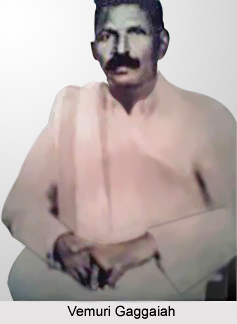 Vemuri Gaggaiah, the famous Telugu theatre personality was very famous for his villainous roles, especially in mythological plays. He was born in the year 1895. Vemuri Gaggaiah was an important member of the Bala Bharathi Nataka Samajam in Mylavaram i.e. Krishna district. This was popularly called Mylavaram Theatre in 1913-28. Gaggaiah became a household name. He won recognition as Yama, god of death, in Sati Savitri i.e. "Virtuous Savitri", as the demon Hiranyakasipu in Bhakta Prahlada i.e. `Prahlada the Devotee`.
Vemuri Gaggaiah, the famous Telugu theatre personality was very famous for his villainous roles, especially in mythological plays. He was born in the year 1895. Vemuri Gaggaiah was an important member of the Bala Bharathi Nataka Samajam in Mylavaram i.e. Krishna district. This was popularly called Mylavaram Theatre in 1913-28. Gaggaiah became a household name. He won recognition as Yama, god of death, in Sati Savitri i.e. "Virtuous Savitri", as the demon Hiranyakasipu in Bhakta Prahlada i.e. `Prahlada the Devotee`.
Some other prominent roles were as the eponymous Mymvana, and as Jalandhara in Sati Tulasi i.e. `Virtuous Tulasi`. This was responsible for his entry into movies as Yama in Savitri in 1933, followed by the evil Kamsa in Sri Krishna lilalu i.e. `Sri Krishna`s Lila` in 1935 and the womanizer in Chandika in 1940. All these plays prove his worth as a performer of tremendous range. He had a thunderous stage voice and his rendering of songs like Po bala pommikan i.e. "Girl, get away from my presence!" and Dhikkaramulsaituna i.e. "Can I tolerate your impudence?" still awes listeners.
The much recognized Telugu theatre personality, Vemuri Gaggaiah died in the year 1955.
This article is a stub. You can enrich by adding more information to it. Send your Write Up to content@indianetzone.com




















